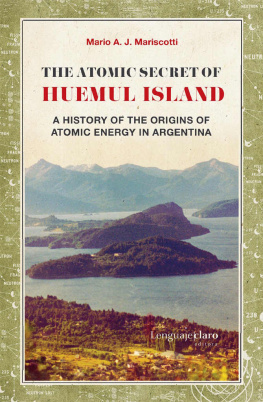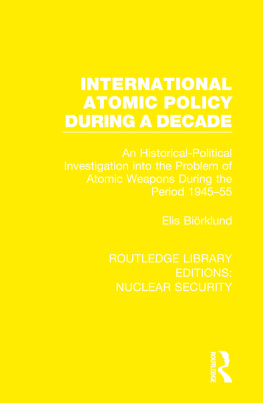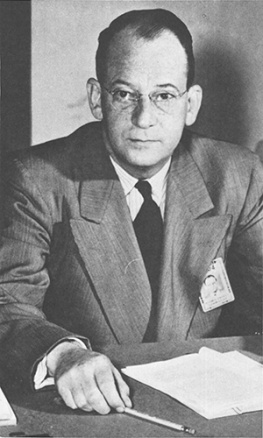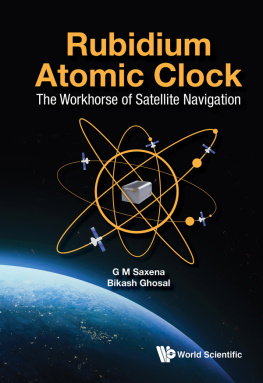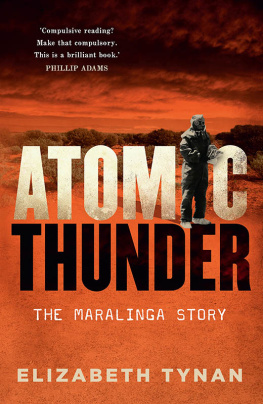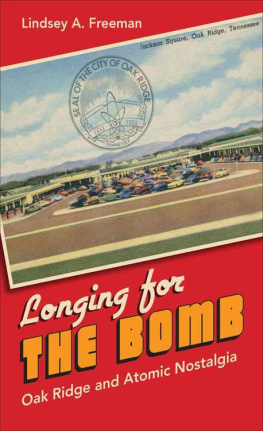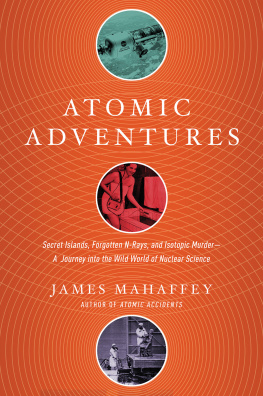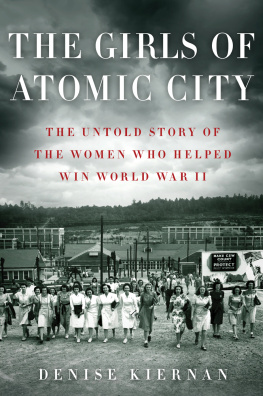Mario A. J. Mariscotti - The Atomic Secret of Huemul Island: A history of the origins of atomic energy in Argentina
Here you can read online Mario A. J. Mariscotti - The Atomic Secret of Huemul Island: A history of the origins of atomic energy in Argentina full text of the book (entire story) in english for free. Download pdf and epub, get meaning, cover and reviews about this ebook. year: 2017, genre: Art. Description of the work, (preface) as well as reviews are available. Best literature library LitArk.com created for fans of good reading and offers a wide selection of genres:
Romance novel
Science fiction
Adventure
Detective
Science
History
Home and family
Prose
Art
Politics
Computer
Non-fiction
Religion
Business
Children
Humor
Choose a favorite category and find really read worthwhile books. Enjoy immersion in the world of imagination, feel the emotions of the characters or learn something new for yourself, make an fascinating discovery.
- Book:The Atomic Secret of Huemul Island: A history of the origins of atomic energy in Argentina
- Author:
- Genre:
- Year:2017
- Rating:3 / 5
- Favourites:Add to favourites
- Your mark:
- 60
- 1
- 2
- 3
- 4
- 5
The Atomic Secret of Huemul Island: A history of the origins of atomic energy in Argentina: summary, description and annotation
We offer to read an annotation, description, summary or preface (depends on what the author of the book "The Atomic Secret of Huemul Island: A history of the origins of atomic energy in Argentina" wrote himself). If you haven't found the necessary information about the book — write in the comments, we will try to find it.
The Atomic Secret of Huemul Island: A history of the origins of atomic energy in Argentina — read online for free the complete book (whole text) full work
Below is the text of the book, divided by pages. System saving the place of the last page read, allows you to conveniently read the book "The Atomic Secret of Huemul Island: A history of the origins of atomic energy in Argentina" online for free, without having to search again every time where you left off. Put a bookmark, and you can go to the page where you finished reading at any time.
Font size:
Interval:
Bookmark:
Table of Contents
Title Page
THE ATOMIC SECRET
OF HUEMUL ISLAND
A history of the origins of atomic
energy in Argentina
Mario A. J. Mariscotti
The Atomic Secret of Huemul Island. A history of the origins of atomic energy in Argentina
2017 Mario Mariscotti
mario.mariscotti@gmail.com
This book has been pirated by magictalent. Knowledge must be free
.
Cover design: Miur
Cover image: The author is grateful to Eduardo Santos
Translation: Isabel de Reynal and Mario Mariscotti
Mariscotti, Mario A. J.
The Atomic Secret of Huemul Island. A history of the origins of atomic energy in Argentina/ by Mario A. J. Mariscotti 1.Atomic Energy in Argentina History. 2. Argentine Physics Association. 3. Richter and Peron. 4. International impact. 5. Huemul Island. 6. Bariloche Atomic Center and Balseiro Institute of Physics. I. Title. II, Title: The Atomic Secret of Huemul Island.
ISBN-13: 978-1545569948
ISBN-10: 1545569940
First Edition in Spanish, Sudamericana Planeta 1984.
Second Edition in Spanish, Sudamericana Planeta, 1987
Third Edition in Spanish, Sigma, 1996
Fourth Edition in Spanish,Sigma, 2004
Fifth Edition in Spanish, Lenguaje Claro, 2016
To Amalia
CONTENTS
Prologue
What led me to undertake the investigation of Project Huemul? To make use of free time in a leisurely holiday? To satisfy my curiosity on a subject that had remained obscure for two decades? To learn how the current activity in nuclear energy in Argentina had come about, more precisely the origins of CNEA, the institution where I worked when I started this project? To fill in the vacuum before some foreign historian would take up the subject, and accomplish what our apathy or negligence has failed to do? To make Argentine society more conscious about this activity of great importance for the country nowadays?
I guess it was a combination of all these reasons which kept me on track when at one time or the other my enthusiasm faded. Beyond these motivations I recall three events which aroused my curiosity in a special way.
The first occurred in an afternoon of 1958 while I was browsing some books in an old family library which was especially appealing because it was in the backyard somewhat isolated. At siesta time on Sundays it was nice to go there and poke around old books at our leisure. There were many books and I never got to explore all of them. Most of them preserved stories which we, the younger generation, had not lived. Opening one of those books was like shaking dust off a glass and discover on the other side the life of our grandparents. That afternoon I was leafing through a collection of the Bibliotheque de Philosofie Scientifique published in the 1930 s, which reproduced papers by Einstein, de Broglie and Poincar. In 1958 I had decided to switch from Engineering to Physics. Being a recent convert, the titles and the authors caught my curiosity and opening the yellowish pages of one volume an old newspaper clip fell to the floor. It was an article that immediately rekindled recollections of my own of a few years earlier. I pictured again the large headlines of Buenos Aires newspapers announcing that Argentina had the Bomb and other similar claims.
I carefully unfolded the frail clipping. It was from 1951, when I was 11 years old. I had only a vague memory of the events that had taken place then. The article described a press conference by Dr. Ronald Richter the central figure of an important atomic development in Argentina. I came upon a dialogue. A journalist asked Richter:
- Was there an explosion? to which Richter had replied:
- "Yes. For example, in a uranium pile there is also a tendency to an explosion, though dwindled and controlled in intensity so as to establish a dynamic equilibrium."
I read again. Had there been an explosion or not? It was a good question followed by a curious answer.
- "But was there a big noise?" insisted the journalist justifiably unsatisfied.
- "Yes, there was a huge explosion."
Now the exchange seemed to make sense, stimulating the wish to know more. But the logical sequence was again broken.
The journalist wanted further details: "Could it have been heard beyond the island?"
- "That depends on whether there is a storm.", was Richters sharp answer.
This intriguing dialogue stayed in my mind for years nourishing an unsatisfied curiosity and I think it was, at least partially, responsible for the making of this book.
The second event that naturally inspired this work was the opportunity of sneaking into Huemul Island in several occasions during my youth.
Playa Bonita is one of the most beautiful places in the vicinity of Bariloche. The view of the Lake Nahuel Huapi and of the Andes from there is exceptional and since 1960 it has been the habitual site of our summer vacations. The lawn slopes down toward the beach. From this vantage point the most notorious geographic element is the Huemul Island, where at one time it stood a secret atomic laboratoryand only 1 mile away. It did not take long to get hold of a canoe and cross the lake to explore this islands secrets.
To get on the island and roam every corner, like one would do with an abandoned castle, was a fascinating pastime. Gradually, we ventured deeper into the underbrush, finding new buildings and structures hidden behind thorns and thistles grown unrestrained for years
The climax was to reach the only laboratory that showed signs of having been used. The main door was not locked so we could get inside. It did not have windows nor electricity so it took a few minutes until we could adjust our eyes and see what was there. In our first visits, some exceptional instruments were still in place. We moved through a dark labyrinth of thick walls to reach the center of a weird chamber. After a couple of yearly visits, we took pride to bring friends there and show them these wonders that still bore the imprints of a mysterious past. There was a huge battery of large condensers and gigantic electronic tubes, the frames of a dash board, 4 holes drilled in the 3 ft. thick shielding walls neatly aiming at the center of a big magnet. Standing there we weaved all kinds of hypotheses, coveting at the same time that Richter could be by our side to tell us the true purpose of all this marvelous setting. So obviously these visits were a real incentive to take up this investigation.
Yet, there was a third motivation for this work, of a different nature but that eventually converged into the same objective of knowing more about the atomic story of Huemul.
When the idea of studying Huemul was born in 1976, I had one year as Chairman of the Department of Physics of CNEA and three as leader of a research group using a particle accelerator called Synchrocyclotron. This machine had been in operation since December 1954 and many new radionuclides were soon after produced thanks to its energetic particle beams. This instrument had been indeed a key element in the early development of nuclear physics in Argentina. Being now in charge of this laboratory I felt I should be acquainted with its past. The list of publications was a good starting point. But I also wanted to know how this big machine, the largest in Latin America, came to be purchased some 20 years earlier, who decided it, what criteria predominated to select this particular type of accelerator, how long the decision process had taken, how much it cost, etc. By that time, we were preparing a proposal for the acquisition of a new accelerator, an additional motive to learn how it had been done before. Hence I went to talk to my older colleagues who had worked in the laboratory but unfortunately they did not know much about its history. Then I went to see Mr. Ernesto Galloni, an able engineer turned physicist, now retired, who had been responsible for receiving the parts of the machine and assembling it. It seemed a sure bet but surprisingly he did not know who had decided to buy this machine. As a last resort I went to see retired Admiral Pedro Iraolagoitia, who was President of CNEA between 1952 and 1955. He did not know either. Naturally far from declining, my curiosity was increasingly aroused at every step. Ultimately, I found the elusive answer in the story of Huemul. This is why the Synchrocyclotron also played a part as an incentive for this work.
Next pageFont size:
Interval:
Bookmark:
Similar books «The Atomic Secret of Huemul Island: A history of the origins of atomic energy in Argentina»
Look at similar books to The Atomic Secret of Huemul Island: A history of the origins of atomic energy in Argentina. We have selected literature similar in name and meaning in the hope of providing readers with more options to find new, interesting, not yet read works.
Discussion, reviews of the book The Atomic Secret of Huemul Island: A history of the origins of atomic energy in Argentina and just readers' own opinions. Leave your comments, write what you think about the work, its meaning or the main characters. Specify what exactly you liked and what you didn't like, and why you think so.

